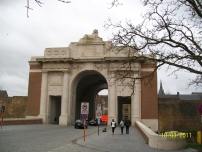| First Name: | Thomas Alfred | Last Name: | TOMPKINS | |
|---|---|---|---|---|
| Date of Death: | 31/10/1914 | Lived/Born In: | Limehouse | |
| Rank: | Lance Corporal | Unit: | Bedfordshire2 | |
| Memorial Site: | 1. Limehouse, St Anne 2. Menin Gate | |||
Current Information:Age-27 2, New Alley, Three Colt Street, Limehouse
First Battle of Ypres Between 21st October and 22nd November, 1914 a desperate fight took place around the Belgium city of Ypres, the first of three major battles that were to be fought there during the course of the war. British troops entered Ypres in October. The 1st and 2nd Divisions plus the 3rd Cavalry Division had made their way up from the Aisne as part of the “Race to the Sea”, whilst the 7th Division came west to Ypres after Antwerp had fallen. The Germans knew that Ypres was the gateway to the Channel ports and that these were vital to Britain’s war effort so they poured reinforcements into the area. The fighting fell into three distinct battles; the Battle of Langemarck, 21-24 October, the Battle of Gheluvelt, 29-31 October and the Battle of Nonne Bosschen, 11 November. Ypres did not fall to the Germans but its defence during these two months resulted in the destruction of much of the old regular British Army. Between 29th and 31st October a massive concentration of German troops tried to break the British line around Gheluvelt at the eastern apex of the Ypres salient. 1st and 7th Divisions stood in their path. On the 29th October, after a day of intense fighting, often hand to hand, the British were pushed back to the Gheluvelt cross roads. The following day the Germans attacked Gheluvelt itself and although the village remained in British hands, German troops had some success further south at Zandvoorde and were now able to enfilade the British line. Then on 31st October came the main German attack and Gheluvelt fell. At one stage the it seemed that all was lost but a dramatic counter attack by 2nd Worcestershire, stabilised the line. However, the loss to the British army had been enormous. On 30th October, the Germans attacked with overwhelming force on a line from Gheluveld to Zandvoorde . The line was breached and in danger of being ‘rolled up’ so, whatever reserves left were rushed into the fray. These included the 2nd Bedfordshire battalion of 21 Brigade, 7th Division, some of whom were sent to the spur midway between Zandvoorde & Gheluvelt to assist the exposed flank there. But it was too little too late and they were soon blown off it. In the early afternoon, 2nd Bedfordshire and some Royal Engineers tried a counter attack south, with their left on the Zandvoorde-Gheluvelt road, but they were forced back by sheer weight of numbers. The following morning, 31st October, the Germans attacked in even greater force. 2nd Bedfordshire and 2nd Royal Scots Fusiliers held the front of 21 Brigade but there was a quarter of a mile gap between them. This gap was exploited by the Germans and there followed a day of bitter fighting with attack and counter attack, trenches lost and trenches regained. Finally 7th Division’s line was re-adjusted to curve back slightly to conform with neighbouring units. One of the many casualties resulting from this day of fierce fighting was Thomas Tompkins of 2nd Bedfordshire. |
||||
| « Back to Search Results | ||||
| If you think any of the information shown here is incorrect, Click Here to submit your amends and comments | ||||




